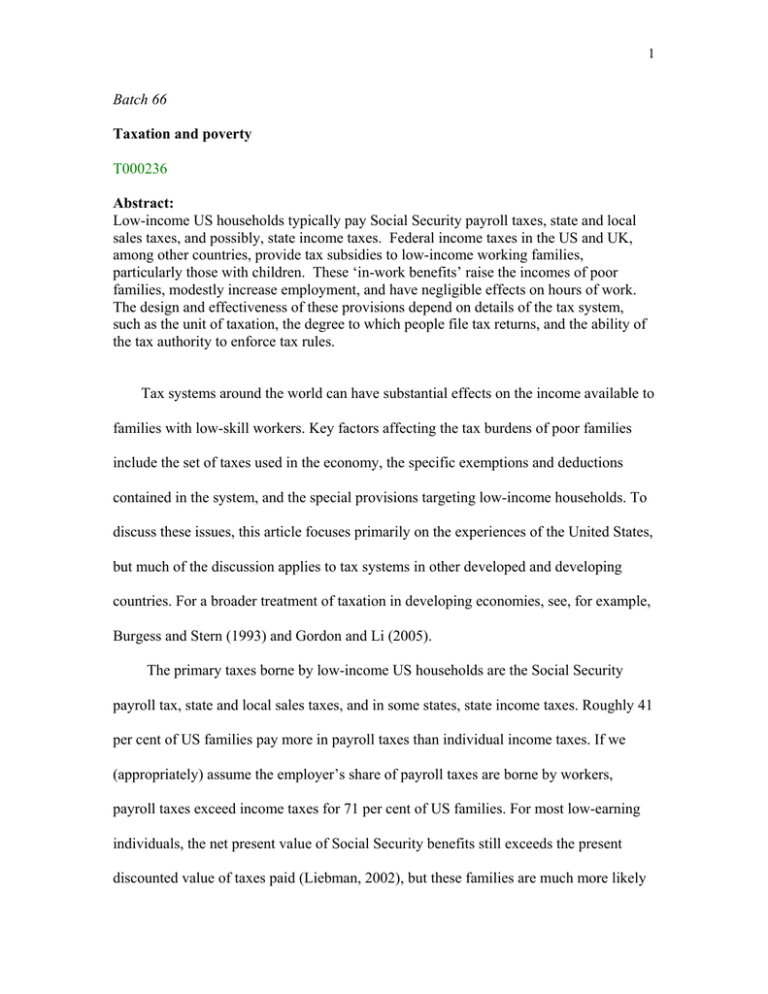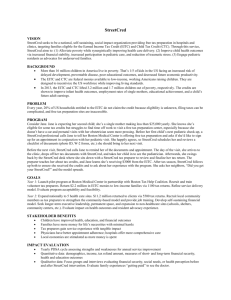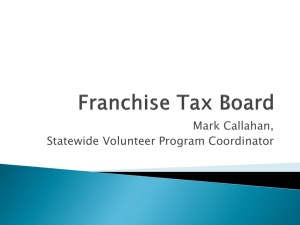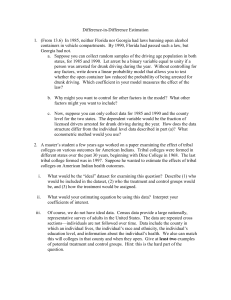Batch 66 Taxation and poverty Abstract: T000236
advertisement

1 Batch 66 Taxation and poverty T000236 Abstract: Low-income US households typically pay Social Security payroll taxes, state and local sales taxes, and possibly, state income taxes. Federal income taxes in the US and UK, among other countries, provide tax subsidies to low-income working families, particularly those with children. These ‘in-work benefits’ raise the incomes of poor families, modestly increase employment, and have negligible effects on hours of work. The design and effectiveness of these provisions depend on details of the tax system, such as the unit of taxation, the degree to which people file tax returns, and the ability of the tax authority to enforce tax rules. Tax systems around the world can have substantial effects on the income available to families with low-skill workers. Key factors affecting the tax burdens of poor families include the set of taxes used in the economy, the specific exemptions and deductions contained in the system, and the special provisions targeting low-income households. To discuss these issues, this article focuses primarily on the experiences of the United States, but much of the discussion applies to tax systems in other developed and developing countries. For a broader treatment of taxation in developing economies, see, for example, Burgess and Stern (1993) and Gordon and Li (2005). The primary taxes borne by low-income US households are the Social Security payroll tax, state and local sales taxes, and in some states, state income taxes. Roughly 41 per cent of US families pay more in payroll taxes than individual income taxes. If we (appropriately) assume the employer’s share of payroll taxes are borne by workers, payroll taxes exceed income taxes for 71 per cent of US families. For most low-earning individuals, the net present value of Social Security benefits still exceeds the present discounted value of taxes paid (Liebman, 2002), but these families are much more likely 2 than others to be intertemporally credit constrained, so, if the payroll tax is fully borne by workers, the 14.2 per cent combined employer–employee tax results in a substantial reduction in after-tax resources available for consumption. (14.2 per cent is the sum of the employer and employee shares of payroll taxes, which equals 15.3 per cent, divided by market earnings increased by the employer’s tax share (1.0765), with the idea that without the payroll tax, employers would increase wages by their share of the tax.) The perceived regressivity of the social security payroll tax was one factor leading to the adoption of the earned income tax credit in the mid-1970s. Sales taxes and their international cousins, value-added taxes, also raise concerns among policymakers that they impose inappropriate burdens on low-income households. Consequently, these taxes frequently exempt items such as food, clothing, and medicine that are thought to typically compose larger shares of poor families’ budgets than is the case for other families. Zero-rating (excluding) items raises a fundamental issue in taxation. Should tax systems be designed to raise the revenues necessary for the operation of government in the most efficient way possible, leaving expenditure policy to address distributional concerns, or should taxes be designed to address equity issues directly? Exempting (or zero-rating) items in a VAT or consumption tax reduces efficiency (for example, see Ballard, Scholz and Shoven, 1987). Whether policymakers deem the exemptions as being necessary depends on political considerations and the strength of other available institutions to redistribute resources to poor families. The federal individual income tax is conspicuously absent from my list of taxes reducing the incomes of poor families. Until around 1974, the federal income tax imposed positive average and marginal tax rates on families with incomes at the US 3 poverty line, so, along with payroll and sales taxes, income taxes (at both the federal and, in some circumstances, the state level) reduced the incomes of low-income working families. In the absence of other tax provisions targeting low-income families or individuals, the threshold at which families began to pay income taxes was determined largely by the size of the standard deduction and exemptions, and whether these provisions were indexed for inflation. In 1974 the difference in average tax rates, combining income and payroll taxes, between a one-adult, two-child family with income at the poverty line and a two-adult, two-child family with income three times the poverty line was 9.2 percentage points, or the difference between 13.2 per cent and 22.4 per cent. By 2005 the difference was 36.9 percentage points, or the difference between -15.3 per cent and 21.6 per cent. (These calculations are made with the NBER’s TAXSIM model: see Feenberg and Coutts, 1993 for a discussion of TAXSIM.) By far the most important factor affecting the tax treatment of low-income families in the United States since 1977 has been the development and expansion of tax provisions targeted to low-income taxpayers that are ‘refundable’ – the Treasury pays out the value of the credit regardless of whether the taxpayer otherwise has positive tax liability. The most important of these is the earned income tax credit, though in recent years, a portion of the child credit has also been made refundable. Refundable credits can result in negative average tax rates for working poor families with children. The antecedent for current tax provisions targeting low-income families is negative income tax (see Moffitt, 2004, for a nice discussion). The negative income tax (NIT) was to provide a basic income guarantee that would be clawed back as earnings increase. In 4 the mid-1970s US policymakers came close to enacting a NIT, and its labour market and family formation effects were studied extensively in a series of closely watched, widely publicized social experiments (see, Robins, 1985; Cain and Wissoker, 1990 for further details). The United States implemented an earned income tax credit (EITC) in 1975. The EITC provides a subsidy to earnings up to a specific income threshold. For example, in 2004 the EITC gave a 40 per cent earnings subsidy up to 10,750 dollars to a family with two or more children. Taxpayers with earnings between 10,750 and 14,040 dollars received the maximum credit of 4,300 dollars. The maximum credit for families with one child is 2,604 dollars; for childless workers it is 390 dollars. The credit was reduced by 21.06 per cent of earnings between 14,040 and 34,458 dollars. Hence, there are three distinct ranges of the EITC: the subsidy, flat and phase-out ranges of the credit. The political appeal of the EITC, and similar programmes in other countries such as the Working Tax Credit in the United Kingdom and an EITC-like earnings subsidy that soon will be implemented in South Korea, rests on at least two factors. First, earnings subsidies like the EITC are thought to encourage work and they are sometimes justified as part of a set of policies to ‘make work pay’. There is considerable evidence that this perception is accurate: the EITC has positive employment effects so, in contrast to many alternative ways of redistributing income from higher- to lower-income families, the EITC does not substantially harm labour market incentives. Second, by adding the EITC to an existing individual income tax, implementation costs are relatively low, particularly compared to programmes that require their own bureaucracy. The static labour supply model implies the EITC will have an unambiguous, 5 positive incentive effect on employment. The empirical evidence is consistent with these incentive effects: the EITC has a statistically significant and large effect on labour force participation of single women with children. Grogger (2003), for example, concludes that the EITC ‘may be the single most important policy measure for explaining the decrease in welfare and the rise in work and earnings among female-headed families in recent years’ (2003, p. 408). For more on the EITC, see Dickert, Houser and Scholz (1995); Eissa and Liebman (1996); Keane and Moffitt (1998); Ellwood (2000); Meyer and Rosenbaum (2000, 2001); and Hotz, Mullin and Scholz (2005). Eissa and Hoynes (2004) focus on the employment and hours decisions of secondary workers in married families and find small, negative effects of the credit on work. Hotz and Scholz (2003) survey EITC research The static labour supply model implies an ambiguous incentive effect of the EITC on hours in the phase-in range of the credit and unambiguous negative incentive effects on hours in the flat and phase-out ranges. Studies estimating the effects of the EITC on hours of work for working households find no bunching of taxpayers at the beginning and end of the phase-out range, as might be expected if the EITC significantly affects hours and taxpayers are cognizant of the discontinuities in implied marginal tax rates generated by the credit (Liebman, 1997). It is not surprising that negative effects on hours for people already in the labour market are small, since the precise relationship between the EITC and hours worked is likely to be poorly understood by most taxpayers. Most EITC recipients pay a third party to prepare their tax returns, and it is difficult to infer the implicit tax rates embodied in the credit from the look-up table that accompanies the EITC instructions. This confusion is less likely to mitigate positive participation effects, 6 since for these to be operative, taxpayers need only to understand that there is some taxrelated bonus to work. Abundant anecdotal evidence indicates that taxpayers have this understanding (see, for example, DeParle, 1999). The UK working tax credit has an interesting design feature when compared with the EITC. Instead of phasing in, it imposes an hours threshold that triggers eligibility, thereby increasing the number of households receiving positive employment and hours incentives in relation to a credit on the first dollar of earnings. All households working fewer than 16 hours will see an increase in the after-tax return to work (and, since they do not receive any credit if they have fewer than 16 hours of work, there is no incentive to ‘buy’ more leisure). Hours limits impose a potentially significant additional administrative burden – because hours information is typically not required to implement an income tax – so their desirable labour market incentive effects must be balanced against the additional costs that arise from administering the hours requirement. Blundell and Hoynes (2004) find the EITC seems to have a larger effect on employment than the WTC predecessor, even though average EITC benefits are somewhat smaller. This may in part be because the incentive effects of in-work benefits in the United Kingdom are dulled by integrations with the rest of the tax and benefit system. The unit of taxation in most countries around the world is the individual, not the family as is the case in the United States. Most policymakers (including those in the United Kingdom), however, believe that it is essential to target tax benefits on the basis of family income, since it is widely believed that families pool resources when making economic decisions. UK tax authorities meet this goal by having taxpayers claim eligibility by submitting a form to the tax authorities during the year, while the claim is 7 recalculated at the end of the year based on family income. The UK experience shows that it is possible to have a credit with family-based eligibility in a tax system where individuals are the unit of taxation. Less is known about the effects of the EITC on other aspects of behaviour. DickertConlin and Houser (2002) and Eissa and Hoynes (2004) provide some evidence that the EITC encourages the existence of female-headed families. Heckman, Lochner and Cossa (2002) examine the effects of the EITC on skill formation. While they emphasize that much more needs to be done, they reach a tentative conclusion that the EITC has little impact on average skill levels in the economy. The EITC appears to reach those who are eligible – participation rates among eligible taxpayers is high (Scholz, 1994). Lastly, the EITC also suffers from high rates of noncompliance (Internal Revenue Service, 2002): many taxpayers who are not eligible end up claiming and receiving the credit. There is probably a trade-off between a policy with low administrative costs, like the EITC, and high rates of noncompliance. John Karl Scholz See also: Antipoverty Programmes in the United States Nutrition and Public Policy in Advanced Economies Poverty Alleviation Low-income housing policy Poverty Welfare State Bibliography 8 Ballard, C. L., Scholz, J. K. and Shoven, J. B. 1987. The value-added tax: a general equilibrium look at its efficiency and incidence. In The Effects of Taxation on Capital Accumulation, ed. M. Feldstein. Chicago: University of Chicago Press. Blundell, R. and Hoynes, H. 2004. Has ‘in-work’ benefit reform helped the labour market? In Seeking a Premier Economy: The Economic Effects of the British Economic Reforms, 1980–2000, ed. R. Blundell, D. Card and R. Freeman. Chicago, Illinois: NBER and University of Chicago Press. Burgess, R. and Stern, N. 1993. Taxation and development. Journal of Economic Literature 31, 762–830. Cain, G. G. and Wissoker, D. A. 1990. A reanalysis of marital stability in the SeattleDenver income-maintenance experiment. American Journal of Sociology 95, 1235–69. DeParle, J. 1999. Once a forlorn avenue, tax preparers now flourish. New York Times 21 March. Dickert, S., Houser, S. and Scholz, J. K. 1995. The earned income tax credit and transfer programs: a study of labor market and program participation. Tax Policy and the Economy, vol. 9, ed. J. M. Poterba.Cambridge, Massachusetts: NBER and the MIT Press. Dickert-Conlin, S. and Houser, S. 2002. EITC and marriage. National Tax Journal 55, 25–39. Ellwood, D. T. 2000. The impact of the earned income tax credit and social policy reforms on work, marriage, and living arrangements. National Tax Journal 53, 1063–105. Eissa, N. and Liebman, J. B. 1996. Labor supply response to the earned income tax credit. Quarterly Journal of Economics 111(2), 605–37. 9 Eissa, N. and Hoynes, H. W. 2004. Taxes and the labor market participation of married couples: the earned income tax credit. Journal of Public Economics 88, 1931–58. Feenberg, D. R. and Coutts, E. 1993. An introduction to the TAXSIM model. Journal of Policy Analysis and Management 12, 189–94. Available online at http://www.nber.org/taxsim/. Gordon, R. and Li, W. 2005. Tax structure in developing countries: many puzzles and a possible explanation. Working Paper No. 11267, Cambridge, MA: NBER,. Grogger, J. 2003. The effects of time limits, the EITC, and other policy changes on welfare use, work, and income among female-headed families. Review of Economics and Statistics 85, 394–408. Heckman, J. J., Lochner, L. and Cossa, R. 2002. Learning-by-doing vs. on-the-job training: using variation induced by the EITC to distinguish between models of skill formation. Working Paper No. 9083. Cambridge, MA: NBER. Hotz, V. J. and Scholz, J. K. 2003. The earned income tax credit. In Means-Tested Transfer Programs in the United States, ed. R. Moffitt. Chicago, Illinois: University of Chicago Press and NBER. Hotz, V. J., Mullin, C. and Scholz, J. K. 2005. Examining the effect of the earned income tax credit on the labor market participation of families on welfare. Mimeo, UCLA and Wisconsin. Available online at http://www.ssc.wisc.edu/~scholz/Research/EITC_Draft.pdf. Internal Revenue Service. 2002. Compliance estimates for earned income tax credit claimed on 1999 returns. Washington, DC: Inland Revenue Service. 10 Keane, M. and Moffitt, R. 1998. A structural model of multiple welfare program participation and labor supply. International Economic Review 39, 553–89. Liebman, J. 1997. The impact of the earned income tax credit on incentives and income distribution. Tax Policy and the Economy, Cambridge, Massachusetts: volume 11, 83– 119. Liebman, J. B. 2002. Redistribution in the current U.S. social security system. In The Distributional Aspects of Social Security and Social Security Reform, ed. M. Feldstein and J. B. Liebman. Chicago and London: University of Chicago Press. Meyer, B. D. and Rosenbaum, D. T. 2000. Making single mothers work: recent tax and welfare policy and its effects. National Tax Journal 53, 1027–61. Meyer, B. D. and Rosenbaum, D. T. 2001. Welfare, the earned income tax credit, and the labor supply of single mothers. Quarterly Journal of Economics 116, 1063–114. Moffitt, R. A. 2004. The idea of a negative income tax: past, present, and future. In Focus. Madison, Wisconsin http://www.irp.wisc.edu/publications/focus/pdfs/foc232a.pdf, volume 23(2)] University of Wisconsin, Madison Institute for Research on Poverty. Robins, P. K. 1985. A comparison of the labor supply findings from the four negative income tax experiments. Journal of Human Resources 20, 567–82. Scholz, J. K. 1994. The earned income tax credit: participation, compliance, and antipoverty effectiveness. National Tax Journal 47(1), 59–81.







